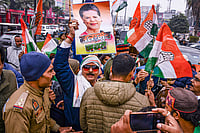The world now has more people than ever before. The population of the world crossed the mark of eight billion on 15 November 2022. The population growth is mainly due to advancements in healthcare, leading to improved lifespan, and reduction in maternal and infant mortality rates. Poverty reduction, too, has been much more than a dip. The world of eight billion is a world of infinite possibilities, states the United Nations sexual and reproductive health agency, UNFPA. Interestingly, even the number 8, when flipped on its side, becomes the symbol of infinity (∞).
Adults (aged 30-64) accounted for more than half of the population growth during the journey from seven billion to eight billion, notes World Population Prospects 2022. This falls in the working age category of the population that is productive, can work and drive the engine of economic growth. Thus, the experts emphasise, it is the right time to reap the opportunity that comes with demographic dividend.
While advanced economies are past the phase of reaping demographic dividend, most of the poorest ones are yet to reach there. “However, there is a notable number of countries that are well-positioned to realise a demographic dividend today,” says Michael Herrmann, Economic Adviser, UNFPA (see accompanying interview).
Andrea Wojnar, UNFPA Representative India and Country Director Bhutan, adds, “The reproductive health and rights of women and girls are key to ensuring societies thrive amid demographic changes. When we are talking about population trends, we are not just talking about census data or surveys –we are talking about a woman’s right to make choices about her body and her future.”
She adds further, “The reproductive rights and health of women must be protected irrespective of demographic trends. Issues like climate change and access to health care disproportionately impact the most vulnerable, especially women and girls. This day should incite the global community to commit to cultivating a world in which all 8 billion of us can thrive equally.”
Opportunities for young India
India is one of those “well-positioned” countries that Hermann talks about. Around the same time as the world reached eight billion, India’s population is estimated to have crossed 1.41 billion (1,414.8 million). Currently the second most populous country, India is projected to overtake China as the most populous one by 2023. As per population projections by the Government of India (2020), India will add an estimated 159 million persons by 2036. Long-term projections by the United Nations indicate an addition of another 175 million persons by 2064 when the country is expected to reach the peak of its population size. India, with 177 million new births, was the largest contributor to reach the milestone of eight billion, points out World Population Prospects 2022. With a median age of 29 years, India is a young country today. The share of the working age population is expected to rise, clearly indicating the window of opportunity to boost economic development.
In 2020, India achieved replacement level of fertility (Total Fertility Rate or TFR of 2.0). A number of states and Union Territories (constituting 69.7 per cent of the country’s population) are below the replacement rate. The issue of high fertility is a matter of concern in a few states like Bihar, Uttar Pradesh, Madhya Pradesh, Rajasthan and Meghalaya.
Speaking on reaping the demographic dividend, social scientist and demographer Shireen Jeejeebhoy says, “States with higher fertility—mostly in the north—have already started sending workers to states in the south and the west where there is a demand for labour. This will continue, and that is the beauty of the way in which India will reap the dividend. This will ensure a greater blending of cultures, food habits and so on, but we need to initiate programmes that support migrants to assimilate in the destination environment.”

Women at the heart of the discussion
Experts point out that fertility will be the most important determinant of the global population trends in the coming decades. BJP parliamentarian Rakesh Sinha has moved a private member’s Bill on population regulation in Rajya Sabha to promote small families of up to two children per eligible couple. He says, “The discourse on population in India is a victim of political agenda. The demographic dividend is a misnomer. Demographers don’t realize the crisis of common people. We are sitting on a volcano.” He adds, “TFR measures average birth by women in her fertility age 14-49 years. This is apt for the western world. Therefore Total Marital Fertility Rate (TMFR) should be applied to children born after marriage.”
Talking on different approach of India towards the population increase, Jeejeebhoy adds, “In many quarters in India, the projection of India becoming the most populous country has raised a few alarms. Some are using this as an opportunity to call for a two-child norm policy, with penalties on those who have more. This is clearly a violation of people’s reproductive rights, as India has committed itself to safeguarding people’s right to bear the number of children they want.”
The argument is that, eventually, bearing a child is a matter of personal choice over which governments should have little say. Referring to the unmet needs for contraception, Jeejeebhoy remarks, “Nationally, one in ten women and about one in six young women—are not practising contraception despite wanting to delay or stop pregnancy—a failure on the part of our health system to deliver contraceptive services and a violation of reproductive rights.”
Need for demographic resilience
The World Population Prospects 2022 suggests that countries with high fertility levels should prepare to meet the needs of growing numbers of children and young people. Dr K S James, Director, International Institute for Population Sciences remarks, “As far as the demographic situation of India is concerned, the picture is quite optimistic. The pace of growth is slower now than in the past. Demographically, we are stable. Fertility has reached replacement level.”

He adds, “The population in the younger age group will be declining. So the bulk of the population will be in the working age. Thus, the current fertility rate is an advantage. Women who earlier used to spend the bulk of their time in child rearing have more time for the labour market. It is important to enhance women’s participation in work, and India needs to do a lot there. It (women’s participation) is increasing, but it has to increase faster.”
In contrast, countries with an opportunity for a demographic dividend need to invest in human capital by ensuring access to healthcare and quality education at all ages and opportunities for productive employment, while countries with ageing populations should take steps to adapt public programmes to the growing proportion of older persons.
Jaydeep Biswas, Chief Policy and Partnerships, UNFPA India, says, “As global population expansion slows and income rises, planning for the next billion will benefit from a focus on increased demographic intelligence and the factoring in of social and environmental costs of economic development.”
He adds, “Experience has shown that improved health, education and gender equality reduce population growth. Lower fertility is strongly linked to greater empowerment and choice exercised by women.”
Building demographic resilience is what will ensure sustainable development. Demographic resilience stresses the importance of anticipating and planning for demographic changes and investing in education, health, gender equality and access to decent work across generations. It emphasises the need to reconsider traditional norms, especially related to the roles of women and men in families and societies, that prevent societies from turning demographic challenges into opportunities.
***

“Realising Demographic Dividend Is Not An Automatic Process”
Michael Herrmann is Economic Adviser at UNFPA. He is engaged in analyzing the linkages between demographic change and development, and supports countries in developing policy responses and building demographic resilience. With the world hitting population of eight billion, he talks on:
Challenges and opportunities:
Virtually all advanced economies have already left the phase of the demographic transition, where they could have reaped a demographic dividend, and many of the poorest economies have not yet entered this stage. However, there is a notable number of countries that are well-positioned to realise a demographic dividend today. Doing so is not an automatic process. It is essential that countries invest in human capital throughout the life course—including health and education—and create equal opportunities for the people to engage in the economy and society at large. Success in realising the first demographic dividend is ultimately also the best way to prepare for the next phases of the demographic transition and the ageing of the population.
Human resources:
Some countries only averted population decline because of relatively high migration to these countries. However, to make the most of migration, it is important that countries have clear and transparent policies on immigration, and it is also advisable that they do more to tap potential that lies in emigration. Rather than viewing emigration as inherently bad, it should be understood as an increasingly normal aspect of life.
Gender dividend:
Greater gender equality is essential not only for achieving desired fertility rates, but also for creating more inclusive societies that are resilient to demographic change. For example, as long as house work and care work for children and parents is largely borne by women, it will be very difficult for women to combine their reproductive and professional aspirations. Furthermore, gender equality is essential to promote a greater engagement of women in the economy and in society at large.
***

Population Policy Reversals
- Singapore introduced the “Stop at two” policy in 1960, following which its TFR went down to 1.4. Faced with issues like reduced economic growth and tax base, increasingly ageing population and higher migrant presence in the workforce, the Singapore government introduced a “Have three” policy targeting young women, incentivising child birth in multiple ways. The efforts have resulted in a slight increase in TFR.
- Japan sought to address the concern over declining fertility rate—it had gone from high to among the lowest in the world in 50 years—by introducing policies to promote child birth through various incentives. While the country has reported an increase in TFR, the pace is slow.
- Greece is seeing the reduction of taxpayer every year due to its shrinking population. From 7 per cent in 1970, a whopping 36 per cent population currently is above the age of 65.
- France has generously incentivised the birth of a third child, including family allowances to improve purchasing power, maternity leave of 40 weeks or more for the third child, tax benefits
Chitra Nair and Naina Gautam





















